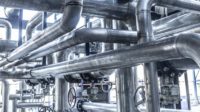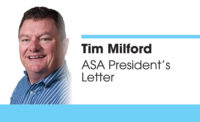With technical advances in industrial, refining, processing and pharmaceutical piping, the use of stainless steel continues to grow. The initial cost is not always the deciding factor. Operating pressures, temperature and corrosion are the primary determinants – and these capabilities are the basic advantages of stainless piping.
When to Select Stainless Steel Piping
Although stainless steel represents only 10% of piping installations, there are certain operations where stainless steel piping is required:
- When corrosion resistance is
needed.
- To prevent contamination, rust and scale (pharmaceuticals).
- To maintain cleanliness in the product being transported (food & beverages).
Other Stainless Applications
Stainless steel has greater strength at elevated temperatures and has the ability to preclude cracking at sub-zero temperatures such as cryogenic requirements of liquid oxygen used in rocket and missile launching.
Example – High Temp. Strength at 1000º F of Pipe/Weld Fittings Based on Allowable Stress
- ASTM A234 Carbon Steel
(WPB) has allowable stress = 2,500 psi.
- ASTM A403 Stainless (WP304) =
13,750 psi.
- ASTM A403 Stainless (WP316) = 15,300 psi.
Economies of THIN WALL Stainless Steel
Because of stainless piping corrosion resistance, many processing plants that operate at relatively low pressures take advantage of the economies of thin wall stainless pipe. The use of Schedule 5S and Schedule 10S pipe with light weight fittings is cost effective rather than the more costly heavier standard wall Schedule 40 pipe and standard wall fittings.
Types of Stainless Steel
There are many kinds and grades of stainless, but the most common for piping is Austenitic (300 Series) that is generally stocked in grades 304 and 316. Type 304 is the most popular and is the lowest cost piping, but some applications require greater corrosion resistance so they must use Type 3l6.
Note: The addition of chrome and nickel to steel is what upgrades it to stainless steel. Type 316 has the addition of 2-3% molybdenum, which gives it much higher corrosion resistance and makes it more expensive than Type 304.
“L” Grades of Stainless Steel (304L & 316L)
When pipe, weld fittings and flanges are welded into piping, the high carbon content of straight grades (304 and 316) form undesirable “chromium carbides” at the weld joints and often require an additional annealing operation to put the carbon back into solution. This extra operation can be precluded by using L-grade (304L or 316L), which limits the amount of carbon so they do not form many chromium carbides.
Note: Today most distributors stock stainless pipe, welding fittings and flanges in 304/304L and 316/316L, which are called dual certified and qualify for both straight grades and L grades.
Material Test Reports
Most stainless weld fittings, stainless pipe, and forged fittings are individually marked during manufacture not only with the manufacturer’s name, spec number, size and pressure, but also with the mill heat number or manufacturer’s control number of each heat for traceability.
Stainless mills provide material test reports (MTRs) with shipments of pipe, weld fittings, forged flanges and valves that are retained in distributors’ files. Copies can be sent with each customer order.
Welded Stainless Pipe Versus Seamless Stainless Pipe
Stainless pipe is manufactured in both welded and seamless methods. Seamless is used in higher-pressure applications. Welded stainless pipe is used in 90% of applications because most process piping is low pressure. There are big savings when using lower cost welded pipe with thinner walls.
Welded Pipe
Stainless welded pipe is manufactured from stainless coil drawn through a series of rollers that roll it into 360-degree tube and continues through the pipe-forming machine as it passes under a heli-arc automatic welding machine, and then is automatically cut into 21-foot lengths.
On lighter schedules, the pipe walls are fused (welded) without filler metal. On heavier walls, weld wire (filler metal) is automatically fed into the prepared v-notch as it is welded by the heli-arc torch. This is a very low labor factor in contrast to the labor-intensive seamless pipe processes.
Seamless Pipe
Seamless pipe is manufactured by piercing solid billets that have been heated to forging temperature and then extruded from the billet (with a hole in the center). The hollow tube is then drawn through a series of rollers to reduce it to the smaller O.D. or is drawn to larger O.D. and required wall thickness. These many operations make seamless pipe very expensive.
Pipe Dimensions and Schedules
Tubular products are termed “tube” or “pipe” with the distinction that pipe is customarily identified by nominal pipe size and wall thickness defined by schedule number or weight. Tubing is customarily specified by its outside diameter and wall thickness.
Pipe O.D. remains constant but the I.D. gets smaller as wall thickness gets heavier, so all have the same size thread and fit all valves, fittings and flanges. Pipe threading can be done only on standard (Sch 40) or heavier pipe as the thinner schedules would not have enough wall thickness to cut threads.
Example - 1-inch Pipe
- Sch 5S OD: 1.315 inch ID:
1.185 inch Wall: .065 inch
- Sch 10S OD: 1.315 inch ID:
1.097 inch Wall: .109
inch
- Sch 40S OD: 1.315 inch ID:
1.049 inch Wall: .133
inch
- Sch 80S OD: 1.315 inch ID:
.957 inch Wall: .170 inch
Note:
- Sch 40S is the same as standard through 10 inch
IPS.
- Sch 80S is the same as extra heavy through 8 inch
IPS.
- Sch 160 and double extra heavy walls are made for severe service such as nuclear.
Stainless Pipe Specifications
ASTM A312 “Seamless and Straight Seam Welded Pipe for High Temperature and General Corrosive Service.” (Most popular type of stainless pipe.)
ASTM A358 “Electric-Fusion-Welded Austenitic Chromium-Nickel Alloy Steel Pipe for High Temperature Service” covers heavy wall welded pipe that requires “filler metal.” It is made with and without radiography depending on the specific application.
ASTM A376 “Seamless Austenitic Steel Pipe for High Temperature Central Station Service” is used in critical applications such as power station and nuclear piping.
ASTM A778 “Welded, Unannealed Austenitic Stainless Steel Tubular Products” is at the other end of the spectrum. It covers thin wall, low pressure and moderate temperature pipe where heat treatment is not necessary for corrosion resistance.
Radiography is not required for this spec. It is sometimes referred to as “as-welded pipe.” It is frequently used in the pulp and paper industry.
Stainless Tubing & Tube Fittings
While the emphasis in this report has been predominantly on stainless pipe and weld fitting applications, there has been dynamic growth in demand for stainless tubing and tube fittings, particularly in sanitary tube applications. While stainless tubing has thin walls that cannot be threaded, the tubing industry has developed a number of fitting connections that have advantages over welding or threading only connections.
Larger size tube fittings are made for attachment by welding similar to butt weld carbon and stainless weld fittings. Tube fittings are also manufactured with attached clamp flanges that are needed in applications where lines must be periodically dismantled and flushed clean of deposits, including hygienic applications, high purity and ultra-high purity such as pharmaceutical, biopharmaceutical and food & beverage applications. Tube fittings in small sizes have their own compression or instrumentation fitting market serving many industries.
Alvin Markus is head of PVF Engineering, consultant to the PVF industry. He is a veteran of 30 years in manufacturing as president of Sunweld Fitting Co.; 15 years distribution with Smith-Cooper International as vice president, engineering & quality assurance; and 18 years as a PVF consultant, including sales and inspection training seminars, and factory audits domestically and overseas. He can be reached at 310-551-5273 or email amarkusla@aol.com.


